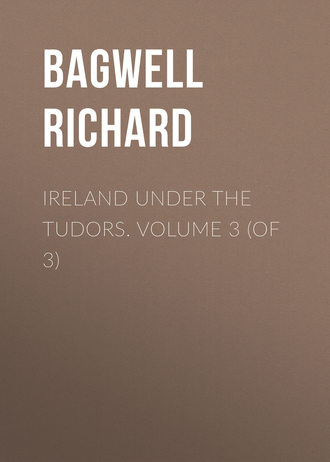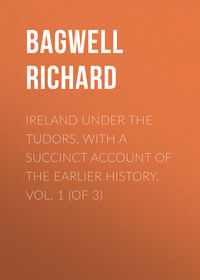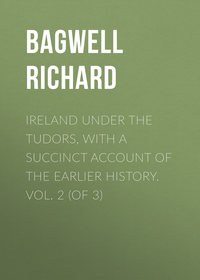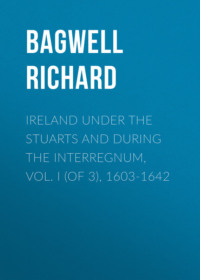 полная версия
полная версияIreland under the Tudors. Volume 3 (of 3)
157
Sidney’s Brief Relation, 1583; Sidney to the Privy Council, Jan. 27, 1577, in Carew; petition of N. Nugent and others, July 1563, in Carew; Answer of B. Scurlock and others, Jan. 11, 1577, in Carew; Fenton to Burghley, Aug. 22 and Sept. 4, 1586; Perrott to Burghley, June 10, 1585; Note of acts, 1586, in Carew, ii. 425. The composition is in Morrin’s Patent Rolls (note to 39 Eliz.)
158
Acquittal of Sir R. Bingham, Feb. 20, 1587; his discourse, July; Bingham to Burghley, Oct. 3, 1587, and Feb. 13, 1588.
159
Perrott to Walsingham, March 7, 18, and 21, and April 1, 1588, and Perrott’s Life; Fitzwilliam’s patent is dated Feb. 17, but he was not sworn till June 30.
160
Perrott to Carew, March 27, 1587, in Carew; Sir N. Bagenal to Burghley, March 26; H. Sheffield to Burghley, March 29; Andrew Trollope to Burghley, Oct. 27 (for Lee’s case); Perrott’s declaration, June 29, 1588, and Fitzwilliam to Burghley, July 31.
161
Wallop to Burghley, April 26, 1586; St. Leger to Burghley, May 30; Sir Roger Wilbraham, S.G., to the Munster Commissioners, Sept. 11, 1587; Arthur Robins to Walsingham, Sept. 17; Andrew Trollope to Burghley, Oct. 19; Sir W. Herbert to Burghley, April 30, 1587, and to Walsingham, July 12, 1588.
162
Morrin’s Patent Rolls, May 10, 29 Eliz., and May 13; Tyrone’s answer, April 1587 (No. 58); Andrew Trollope to Burghley, Oct. 26, 1587; Tyrone to Perrott, Jan. 4, 1588; Perrott to Walsingham, May 12; Bingham to Burghley, May 15; Wallop to Walsingham, June 21.
163
Carew to Burghley, July 18 and Aug. 2, 1588; to Walsingham, July 18, Aug. 4 and Sept. 18; to Heneage, July 18 and Aug. 4, all in Carew.
164
Examination of Emanuel Fremoso and Emanuel Francisco, Sept. 12, 1588; James Trant, sovereign of Dingle, to Sir Edward Denny, Sept. 11; Bingham to Burghley, Aug. 26; Ormonde to Mr. Comerford, Sept. 18. Recalde’s ship was burned by Drake at Corunna in April 1589; she had then sixty-eight pieces of brass cannon. See Duro’s Armada Invencible, ii. 446. ‘Cuando torne’ were Recalde’s words.
165
Examination of Juan Antonio of Genoa, Sept. 15; Vice-President Norris to Walsingham, Sept. 8 and 9; William Herbert to Fitzwilliam, Feb. 1589; Peter Grant’s news under Feb. 28.
166
Nicholas Kahane to the Mayor of Limerick, Sept. 12; George Woodloke to the Mayor of Waterford, Sept. 10; Boetius Clancy, sheriff of Clare, to Bingham, Sept. 6. Mr. James Frost, of Limerick, writes as follows: – ‘One ship was driven upon the rocks at a place called Spanish Point (Rinn na Spainig) near Miltown Malbay… The tradition is that the other ship was driven ashore at a place called Ballagh-a-line, not far from Lisdoonvarna. Boetius Clancy of Knockfime, a place one mile distant from the scene, was sheriff of Clare in that year. He ordered such of the crew as came alive on the shore to be hanged, and they were buried in one pit near the church of Killilagh. The place of execution has been long since called Knockacroghery (the hangman’s hill) and the tumulus of earth heaped over the dead Spaniards is called Tuaim na Spainig. In a few years afterwards, peace being restored between England and Spain, a request was made to the English Government for permission to exhume the body of the son of one of the first grandees of Spain, who had been on board the lost ship, in order to its removal home for burial. Consent was given, but the body having been placed with the rest in one grave, could not be found. Clancy was greatly blamed by all parties for his inhumanity.’
167
Edwarde Whyte to Walsingham, Sept. 30; Ormonde to Comerford, Sept. 18.
168
Edwarde Whyte to Walsingham, with discourse enclosed, Sept. 30; examination of Don Luis de Cordova, Oct. 1.
169
Duro, i. 34, 44, 200, ii. 374, 440, ib. 66-70 for the names of the noble volunteers, among whom is ‘Manuel Paleologo,’ with two followers. —Froude, xii. 503.
170
The most circumstantial account of De Leyva’s adventures, so far, is the deposition, taken on Dec. 29, of James Machary, a Tipperary man who was on board the ‘Santa Ana.’ Other particulars are in the ‘discourse’ sent by E. Whyte to Walsingham on Sept. 30. See also Fitzwilliam to Burghley, Oct. 27, with the enclosures; Duro, i. 171 Gerald Comerford to Bingham, Sept. 13.
171
Bingham to the Queen, Dec. 3; Fitzwilliam, &c., to the Privy Council, Dec. 31; Duro, ii. 65; advertisement by Henry Duke, Oct. 26.
172
Machary’s examination, Dec. 29, and that of George Venerey, a Cretan. Duro, ii. 66-70, 364. The gentleman-adventurers who sailed both on the ‘Rata’ and ‘Santa Ana’ were doubtless collected on board the ‘Gerona.’ Captain Merriman, writing to Fitzwilliam on Oct. 26, says 260 bodies were washed ashore, as well as certain wine, which was appropriated by Sorley Boy MacDonnell. A small cove close to the Giant’s Causeway is still called Port-na-Spania. There is a local tradition that the fallen pillars of basalt on the height were knocked down by the Spanish gunners, who mistook them for Dunluce Castle; but they were not thinking of bombarding castles just then.
173
Cuellar’s narrative in Duro, ii. 342; Sir Geoffrey Fenton to Burghley, Oct. 28. The following is from Col. Wood Martin’s History of Sligo, 1882: ‘The largest of the galleons struck on a reef (from that circumstance called Carrig-na-Spania, or the Spaniard’s Rock) situated off the little island of Derninsh, parish of Ahamlish. On the map of the Sligo coast (A.D. 1609) is placed opposite to this island the following observation: – “Three Spanish ships here cast away in A.D. 1588.”’ The bodies lay on Streedagh strand, and cannon-balls and bones have been cast up there within the last few years.
174
Duro, i. 123, ii. 343-347.
175
Duro, ii. 347-350.
176
Duro, ii. 350-358. The chief who sheltered Cuellar is called by him Manglana, and in the State Papers MacGlannagh or MacGlannahie. ‘The barony of Rossclogher in Leitrim,’ says O’Donovan, ‘was the territory of the family of Mag-Flannchadha, now anglicised MacClancy.’ —Irish Topographical Poems, xxxvii. 268.
177
Duro, ii. 358-360. Cuellar calls all the Irish – men and women, chiefs and kerne – by the same name, ‘salvajes.’
178
The work quoted is La Armada Invencible, by Captain Cesareo Fernandez Duro of the Spanish navy, Madrid, 1885. For my first acquaintance with this book, which deserves translation, I am indebted to a charming article by Lord Ducie in the Nineteenth Century for September 1885. Neither Captain Duro nor Lord Ducie can explain the words ‘D. Reimundo Termi Obispo de Times,’ nor can I. The Irish word Termon may have something to do with it, but whatever ‘Termi’ and ‘Times’ may mean, ‘Reimundo’ is good enough Spanish for Redmond. A year later Bishop O’Gallagher is mentioned in a State paper as ‘Legate to the Pope and custos Armaghnen … using all manner of spiritual jurisdiction throughout all Ulster … these twenty-six years past and more.’ The Spanish captain’s prayer was heard till 1601, when the bishop was killed by the English not far from the place where Cuellar had kissed his hand. Brady’s Episcopal Succession, s.v. Four Masters, 1601. Note of Popish bishops, &c. by Miler Magrath, calendared at Dec. 17, 1590.
179
From a careful comparison of accounts I venture to distribute the wrecks as follows: —
• 1. To the south of Slea Head (‘in Desmond’ Fenton says);
• 1. ‘Nuestra Señora della Rosa’ (945 tons, 26 guns, and 297 men), between Slea Head and the Blaskets;
• 1. Deserted and burned near Carrigaholt in Clare;
• 1. At Dunbeg in Clare;
• 1. At Trumree in Clare;
• 1. The ‘White Falcon’ (500 tons, 16 guns, 197 men), in Connemara;
• 2. In Clew Bay (of which one was the ‘Rata,’ 820 tons, 35 guns, 419 men);
• 1. In Tyrawley;
• 3. Near Sligo, the ‘San Juan de Sicilia,’ one of them (800 tons, 26 guns, 342 men);
• 2. At uncertain places in Connaught;
• 2. At Killybegs;
• 1. The transport ‘Duquesa Santa Ana’ (900 tons, 23 guns, 357 men), at Loughros Bay;
• 1. In Boylagh, Donegal;
• 1. The ‘Trinidad Valencera’ (1,100 tons, 42 guns, 360 men), on the Innishowen side of Lough Foyle;
• 1. The ‘Gerona’ galeass (50 guns, 290 men), between Dunluce and the Bann.
This makes twenty, and there were probably two or three more lost. The ‘Barca de Amburg’ (600 tons, 23 guns, 264 men) sank off the coast somewhere.
The numbers of men given in this note are from the Spanish official list (Duro, ii. 60), but we know that many were transferred from one vessel to another. See, besides the authorities already cited, Fenton’s note calendared at Sept. 19, 1588, and Bingham to the Queen, Dec. 3. Other ships mentioned in Spanish accounts as having been lost in Ireland are the galleon ‘San Juan Battista’ (750 tons, 24 guns, 243 men); the ‘Anunciada’ (703 tons, 24 guns, 275 men), and the transports, ‘Gran Grifon’ (650 tons, 38 guns, 286 men), and ‘Santiago’ (600 tons, 19 guns, 86 men). —Duro, ii. 328.
180
Note by Fenton, Sept. 19; Bingham to Fitzwilliam, Sept. 21 and Oct. 10; to the Queen, Dec. 3; Norris to Walsingham, Sept. 8 and 9; advertisements from Henry Duke, Oct. 26; Fitzwilliam, Loftus, and Fenton to the Privy Council, Dec. 31.
181
Lord Deputy and Council to the Privy Council, Oct. 12, with twenty enclosures; Fitzwilliam to Burghley, Oct. 27, with six enclosures; Solomon Farenan to Fitzwilliam, Feb. 18, 1589; Bingham to Fitzwilliam, Jan. 3, 1592; Fitzwilliam to Burghley, May 9, 1592.
182
Duro, ii. 450 sqq.; examination of Don Alonso de Luzon, &c., Oct. 13, 1588; Fitzwilliam to Burghley, Dec. 31. Sir Horatio Pallavicino arranged with Walsingham for the ransoms; see his accounts, Dec. 1589, No. 85, and Oct. 31, 1591, also G. B. Guistiniano to Burghley, April 8, 1591. On March 14, 1594, Tyrone made it an article against Fitzwilliam that neither he nor the Hovendens had been rewarded for their service.
183
Bingham to Fitzwilliam, Sept. 21, 1588; Sir W. Herbert to Walsingham, Dec. 27, 1588; Lord Deputy and Council to the Privy Council, Dec. 31 and Jan. 30, 1588-9; see also several letters in Carew from June 2 to Aug. 1, 1589. The most important relic that I know is a very handsome table preserved at Dromoland; it was washed ashore near Miltown Malbay, and tradition says that it was ‘in the admiral’s cabin;’ but Sidonia never went near the coast of Clare. Lord Inchiquin writes that a letter, supposed to be still extant, accompanied the table to Dromoland, but that he has been unable to find it. An iron chest washed ashore near the Giant’s Causeway is in Lord Antrim’s possession. The Macnamara family formerly possessed cups, a watch, crosses, &c., out of the Armada, brought from the Arran Islands, but these I have been unable to trace; guns have been recovered, but not many, and the rudder of a ship was cut into gateposts near Westport!
184
For the poems see Duro, i. 237, and ii. 85; examination of Spaniards taken at Tralee, Sept. 9, 1588; Fitzwilliam to Burghley, Oct. 27, with enclosures; examination of James Machary, Dec. 29, &c.
185
Fitzwilliam to Burghley, March 14, 1589, with enclosures; Drake and Norris to the Privy Council, May 7, printed in Barrow’s Life of Drake Smith’s Cork, i. 216.
186
Notices in the Calendar of S. P. Scotland, especially Oct. 28, 1588.
187
Fitzwilliam to the Privy Council, Dec. 31, 1588; to Burghley, Aug. 20, 1590; Robert Legge to Burghley, Feb. 17, 1590; Four Masters, 1588; Fynes Moryson, 1589; compare Captain Lee’s account in Desiderata Curiosa Hibernica, i. 129. Sir John O’Gallagher is called Sir Owen O’Toole in some English accounts, but this is wrong and misleading; the Christian name is Eoin not Eogan. Fynes Moryson was not in Ireland in 1588, and very probably copied Lee’s story.
188
Fitzwilliam to the Privy Council, Dec. 31, 1588; Tyrone to Walsingham, Feb. 5, 1589; Patrick Foxe to Walsingham, Feb. 12.
189
Book of the proceeding of Commissioners for ‘aryer’ claims in Munster, Sept. 3, 1588, of which there is a copy or rather a version (Aug. 29-Sept. 14) at Hatfield, with many details. Most of the facts in this and the two preceding paragraphs are from Mr. Hamilton’s Calendar 1588-1592. See also No. 128, 1591, in Carew. In 1597 Sir Nicholas Browne prophetically described the settlers as ‘fowls fatted in mews, to be spoiled at the pleasure of the country people’ (MS. Cotton, privately printed by Mr. Hussey.)
190
Everything about Florence MacCarthy may be read in his Life and Letters by Daniel MacCarthy, a book of much research, but unfortunately even more chaotic than the common run of family histories.
191
The documents are collected in Shirley’s History of Monaghan, pp. 80-91. The notes in O’Donovan’s Four Masters are very incorrect in this case, though they have often been copied. Essex was much pressed to surrender his patent for Farney, but steadily refused.
192
Sir N. White to Burghley, April 7 and May 9, 1589; report by Bingham, April 10, and his answer to charges in November (No. 39).
193
Among many papers concerning Browne, see his letter to Walsingham, June 10, 1585; Bingham to Perrott, July 30, 1586; Patrick Foxe to Walsingham, Feb. 26, 1589. The murder took place between the last date and Jan. 13, when Bingham’s commission to Browne was signed. For Walsingham’s views see Morrin’s Patent Rolls 26 Eliz. (No. 39). The Four Masters make out that Browne and Daly were killed in battle, but this was clearly not the case.
194
Bingham to Burghley, April 6, 1589; Fitzwilliam to Burghley, April 9, with fourteen enclosures.
195
Report of the Commissioners in Fitzwilliam’s letter to Burghley May 14, 1589.
196
Bishop of Kilmore to Burghley, May 10, 1589; Bishop of Meath to same, May 13; Fitzwilliam to same, May 14, with enclosures; Bingham to Walsingham, May 23.
197
Bingham to Burghley, Feb. 24, May 15 and 28, Aug. 26, 1588; Perrott to Walsingham, March 18, 1588; Gardiner, C.J., to Walsingham, Jan. 31, 1589; case of O’Connor Sligo, Feb. (No. 53); Walsingham to the Bishop of Meath, June 24; Kildare to Nottingham, May 31, 1590; and a paper dated Feb. 21, 1592; William Nugent’s Articles, Aug. 14, 1591.
198
Fitzwilliam to Burghley, July 19, 1589; Bingham to Walsingham, July 24 and Sept. 4; the Articles are printed from a Cotton MS. in O’Flaherty’s Western Connaught, p. 396.
199
Walsingham to Fitzwilliam, July 8, 1589; Fitzwilliam to Burghley, Aug. 9, Sept. 2, Oct. 6, and Dec. 19; Summary of rebellion by John Merbury, Aug. 1. Fitzwilliam calls Bingham ‘atheist,’ but Bishop Jones (to Burghley, May 13) said he was ‘a gentleman of great value, and one that feareth God.’ The Bishop sums up the causes of his great unpopularity under four heads: – 1. Hanging gentlemen by martial law. 2. Commissions to prosecute protected persons by fire and sword. 3. Dispossessing men from their land by ‘provincial orders’ without legal trial. 4. Oppression by the soldiers.
200
Bingham to Walsingham, June 24, 1589; Bingham’s answer to charges, Nov.; Sir N. White to Burghley, Dec. 5; Bishop Jones to Burghley, Dec. 6, and to Walsingham, Dec. 8; Loftus to Walsingham, Dec. 8; Fitzwilliam to Burghley, Dec. 13.
201
The composition with O’Rourke, and much else concerning Leitrim, may be read in Hardiman’s notes to O’Flaherty’s Western Connaught, pp. 346-352; Bingham’s Discourse, July 1587; Bingham to Burghley, May 15 and 28, 1588; John Crofton and others to Bingham, Oct. 19, 1588; Bingham to Fitzwilliam, March 6, 1589; Fitzwilliam to Burghley, with enclosures, April 30; John Merbury to Burghley, Sept. 27, 1589.
202
Bingham to Burghley, April 6, 1589; Fitzwilliam to Burghley, April 9, 1589, and Oct. 31, 1591; John Ball’s declaration, April 1590 (No. 96); John Bingham to Burghley, Aug. 8, 1591.
203
Captain Nicholas Mordaunt to Fitzwilliam, May 11, 1589; Fitzwilliam to Burghley, Oct. 6; Account of O’Rourke’s country by Fenton and Burghley, Feb. 1592 (No. 43).
204
Theobald Dillon to Burghley, Oct. 18, 1589; Edward Whyte to Sir N. White, Oct. 20; the Queen to Fitzwilliam, Nov. 19; Fitzwilliam to Burghley, Dec. 19; to the Privy Council, Jan. 27 and March 2 and 24, 1590, with enclosures; Bingham to Burghley, April 7.
205
Fitzwilliam to Burghley, March 24, 1590, with enclosures; Bingham to Burghley, April 23; Camden. Bruce’s Letters of Elizabeth and James VI., April 1591. The charges against O’Rourke are detailed in the Egerton Papers; O’Sullivan Bere, tom. iii. lib. ii. cap. 1; Four Masters, 1590 and 1591. It is stated in O’Donovan’s notes to the Annals, and in many other places, that O’Rourke begged to be hanged with a withe, and Bacon’s essays are given as an authority; but this is not what Bacon says. His words (No. 39, ‘Of Custom and Education’) are: ‘I remember in the beginning of Queen Elizabeth’s time of England, an Irish rebel condemned put up a petition to the Deputy that he might be hanged in a withe and not in a halter, because it had been so used with former rebels.’
206
Relation by Carew, May 28, 1590, and his letters of May 31 and July 26 to Burghley, Raleigh, and Heneage, all in Carew. The Master of the Ordnance evidently sympathises with the poor soldiers. See also Loftus to Hatton and Burghley, May 31.
207
Walsingham’s opinion and other papers in April 1587; Lord Deputy and Council to the Privy Council, March 31 and May 15, 1589; Kildare to Burghley, May 31, 1590; Tyrone’s answer to Articles, March 19, 1590. All Fitzwilliam’s letters during this period bear out the text; see the Four Masters, who say Hugh Gavelagh was greatly lamented, and O’Donovan’s notes under 1590.
208
Archbishop Magrath’s report to the Queen, May 30, 1592; for Sir Arthur O’Neill see Tirlogh Luineach’s petition, July 1, 1587; for the MacShanes see Tyrone’s answer to Articles, March 19, 1590, and the opinion of Coke, S.G., Aug. 13, 1592.
209
The O’Donnell tangle may be understood from Archbishop Magrath’s report, May 30, 1592, and from the Appendix to O’Donovan’s Four Masters See also Fitzwilliam, Loftus, and Fenton to the Privy Council, Dec. 31, 1588.
210
Four Masters, 1587; Perrott’s Life, p. 278; Tyrone to Walsingham, Dec. 10, 1587.
211
Four Masters, 1590; Note of pledges in Dublin Castle, Aug. 1588; Fitzwilliam to Burghley, Nov. 29, 1589, and to Sir G. Carew in Carew, Jan. 15, 1591.
212
Lord Deputy and Council to the Privy Council, Aug. 21, 1591; Sir H. Bagenal to Burghley, Aug. 13; Tyrone to the Privy Council, Oct. 31.
213
The documents are collected in the Irish Arch. Journal, N. S. vol. i. pp. 298-314. One of Tyrone’s main grievances against Bagenal was that he would not pay him the 1,000l. reserved to his sister by her father’s will; and he continued to clamour for this money even after poor Mabel’s death.
214
Four Masters, 1592. On Feb. 27, Gardiner, C.J., writes to Burghley that Hugh Roe is back in Donegal; under May 31, 1589, there is a list of twenty-two prisoners who had escaped from Dublin Castle, of which eleven had been brought back, but Hugh Roe is not mentioned. In 1594 Henry, Con, and Brian MacShane were all in Tyrone’s custody; (No. 139) in Carew of that year.
215
Four Masters, 1592; Fitzwilliam to Burghley, July 7. Captain Lee, in Desiderata Curiosa Hibernica, vol. i. p. 106, says Willis had with him three hundred of the very rascals and scum of that kingdom, which did rob and spoil that people, ravish their wives and daughters, and make havoc of all.
216
Four Masters, 1592; Tyrone to Burghley, Aug, 2; Fitzwilliam to Burghley, Aug. 8.
217
Loftus to Burghley, Dec. 27, 1590, and Feb. 4, 1591; Lloyd’s State Worthies. Loftus began the attack by recommending Philip Williams to Burghley, Dec. 18, 1586. Williams’s wife applied to Jones a few days later, and the Archbishop forwarded her letter, Jan. 1, 1587. Fitzwilliam wrote to Burghley in favour of Williams, Sept. 17, 1590; see also Sir R. Bingham to Geo. Bingham, Oct. 29, 1591.
218
The forged letter is dated June 25, 1585, and calendared Feb. 16, 1590; Commission dated March 20, 1590, from the Privy Council to the Bishops of Meath and Leighlin, Sir L. Dillon, Sir N. White, Sir E. Moore, Sir E. Waterhouse, Walshe, J., and Calthorpe, A. G. Dillon and White to Burghley, June 26 and 28, 1590; Bishop Meredith to Burghley, July 13, 1590. Fitzwilliam’s letters are too numerous to cite; their general tenour bears out the text; many letters as to Trevor, especially Sir R. Bingham to G. Bingham, Oct. 29, 1591. For the priest Roughan see an amusing account in Strype’s Life of Aylmer, and for Perrott’s quarrel with Loftus and Jones see his Annals (Eliz.) book ii. chaps. 3 and 4. For evidence of Roughan’s perjuries see Morrin’s Patent Rolls, 42 Eliz. No. 21.
219
Lord Campbell’s Chief Justices, i. 247; Howell’s State Trials, vol. i.
220
Introduction to Swift’s Polite Conversation; Naunton’s Fragmenta Regalia; Howell’s State Trials. There is a curious account of Sir Thomas Perrott’s marriage with Lady Dorothy Devereux in Strype’s Aylmer.
221
Fitzwilliam and Bagenal to Burghley, July 25, 1592; Mr. Solicitor-General Coke to Burghley, Aug. 13; Four Masters, 1593. By the articles of agreement concluded at Dundalk on June 28, 1593, Tirlogh Luineach was awarded a life-interest in the Strabane district, while the Earl’s supremacy was acknowledged over all Tyrone.
222
Bingham’s letter of June 28, 1593, is quoted in Brady’s Episcopal Succession, i. 223; O’Sullivan Bere, tom. iii. lib. 2, cap. 6. There is an original intercepted letter at Hatfield from Primate MacGauran to Captain Eustace, dated Madrid, June 28, 1591, in which the writer says: – ‘I hope in God Ireland will soon be free from Englishmen, and notwithstanding that the Catholic King his captains be slow in their affairs, I am certain that the men now purposed to be sent to comfort the same poor island, which is in distress a long time, will not be slow. I ought not to write much unto you touching those causes, for I know that a Spaniard shall be chief governor of them. The Irish regiment is written for.’




